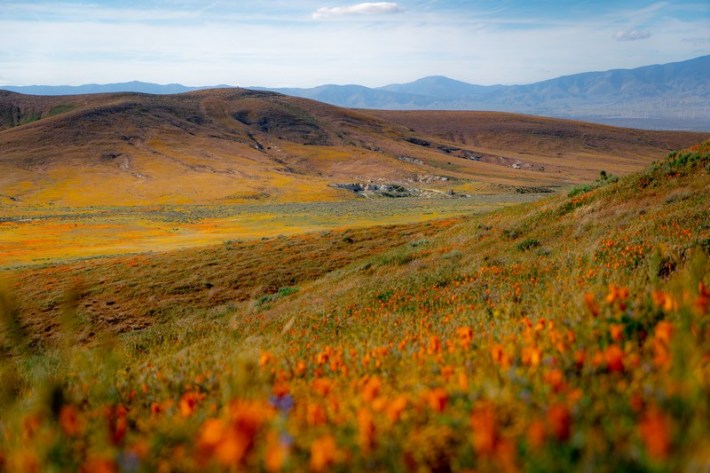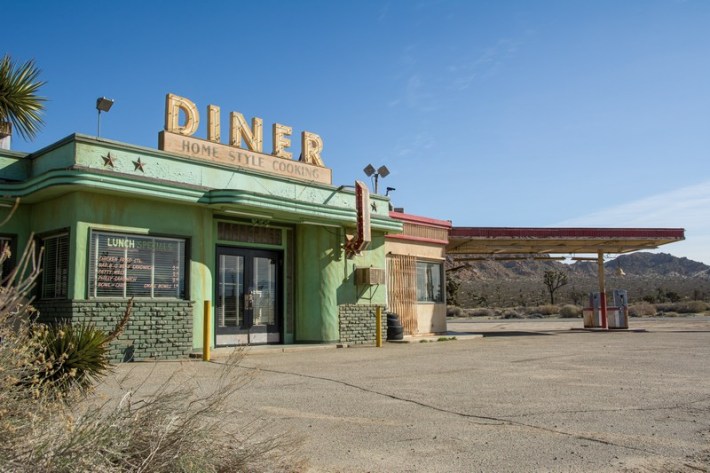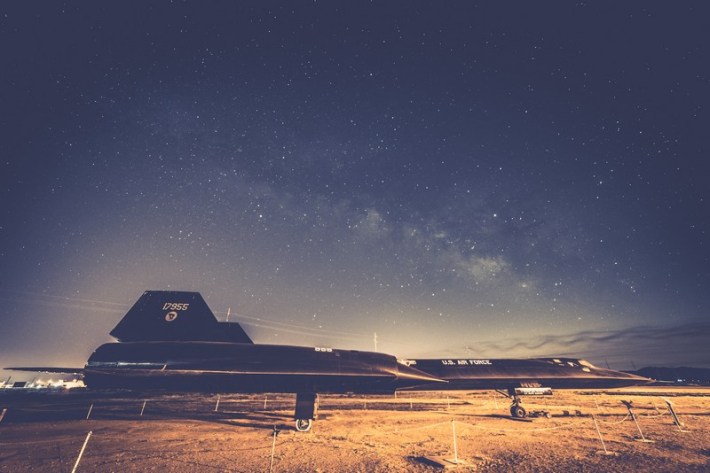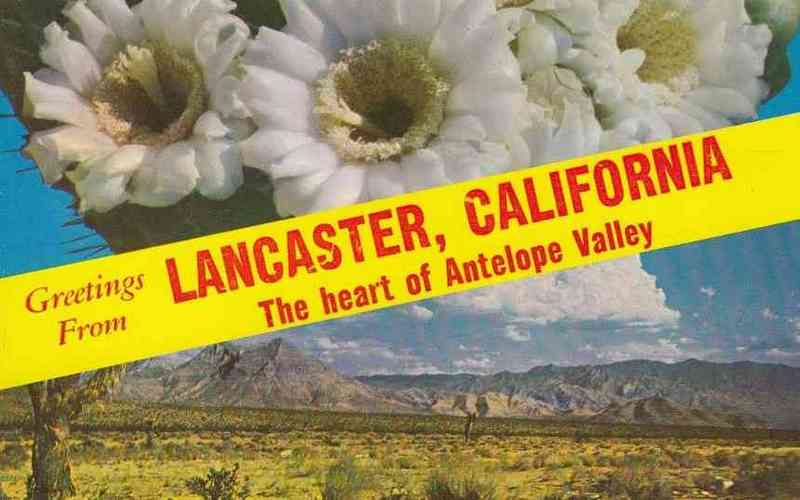As discussed in our recent look into the history of neighboring Palmdale, the Antelope Valley, the modern day region where Lancaster is found, was an important part of a historic trade route used by numerous Indigenous cultures stretching through our continent’s southwest region, including the coast of California and our contemporary Central Valley, the Great Basin, and the pueblos of Arizona. This Valley was home to indigenous societies for over 11,000 years. Lancaster’s Antelope Valley Indian Museum, part of the California Parks system, has a large collection of Native artifacts and seeks to preserve Native history in the region.
Following the establishment of the state of California, the Valley featured two mail and stage coach routes crucial to the pioneering age and the Gold Rush up north. These routes were eventually replaced by train tracks, as Southern Pacific Railroad roared into the area and established a watering facility for locomotives, section gang housing for workers, and a station house right in the bullseye of contemporary Lancaster, eventually connecting L.A. to San Francisco on this line and bringing a lot of new people to the area.

Much of the modern history we’ve gleaned about Lancaster comes from the city itself, which taps a 1913 report by high school students. Kids were way smarter back then. But even they aren’t entirely sure how the town officially got its name. It could have come from a railroad employee, but the records were destroyed in a 1906 fire. Or, like a number of other western towns and street names, dubbed for the East Coast hometown of someone who originally settled here, in this case Lancaster, Pennsylvania.
Mississippi-born lawyer and real estate magnate Moses Langley Wicks is credited with developing the town, having purchased his property from the railroad for $2.50 an acre in 1884 before mapping the whole place out and flipping the land at $6 an acre. The town began to boom over the next fifteen years, with its own newspaper and a profitable spread of wheat and barley farms. However, ten years of drought, starting in 1894, was devastating to the agriculture and livestock industries, helping drive the area’s cattle ranchers to literally greener pastures further north.

trommelkopf/Unsplash
And then… GOLD! In the late 1890’s, both gold and borax were discovered here, with nearby Rosamond’s now shuttered Tropico Gold Mine briefly boasting the largest goldmine in Southern California and the Pacific Coast Borax Company’s mine eventually becoming the biggest in the world, responsible for almost 50% of the world’s borate supply. The city further boomed with the advent of the L.A. Aqueduct in 1908, which brought both water and workers on the project to the area.
The community boomed again due to the military industrial complex kick-started by World War I. There are few identifiable places on Earth associated with the aerospace industry and defense more than Lancaster, where Edwards Air Force Base (originally Muroc Bombing and Gunnery Range) began construction nearby in 1933 at a former railroad water stop. Muroc Dry Lake was targeted as a good place for bombing practice given the absence of people, while a nearby dude ranch was opened by aviator and stunt pilot Florence Lowe “Pancho” Barnes in the base’s shadow, her wild parties later depicted in the famous book about high-speed pilots and astronauts, The Right Stuff, by Tom Wolfe. Among the numerous historical things to happen at EAB include Chuck Yeager exceeding the speed of sound in a jet in 1947 and the first landing of the Space Shuttle. Tens of thousands of jobs were created in the area due to the base being here, as other major defense and aeronautics companies rallied to the region.

That’s not to say everyone is a rocket scientist in this place. Charles Johnson, the president of the International Flat Earth Society, moved his headquarters to Lancaster in 1971, six years before it would be incorporated into the city of Los Angeles. He heard NASA talking all that rigorously-tested science stuff and was all like, “No! Don’t believe them, everyone,” rejecting everything and anything that countered the belief that Earth is shaped like a compact disk.
Still, Lancaster has produced some stupendous locals (shout out to L.A. TACO’s own Samantha Nunez). Guitar god Frank Zappa’s dad worked as an engineer at Edwards Air Force base and Maryland-born, Lancaster-raised Frank attended both Antelope Valley High and College, respectively, where he conducted the school orchestra and played with early bands including the Blackouts and the Omens. Some of our favorite Lancaster locals, or people with connections to the area, include Air Force brat and Three’s Company star Priscilla Barnes, Donald “Childish Gambino” Glover (born at Edwards Air Force Base), boxer Chris Avalos, and the legendary Judy Garland, whose father owned a local movie theater after the family moved here in her early childhood.
Lancaster also produces significant amounts of sunlight and produces the most solar power per resident in the whole state. The city, which is currently 50% solar-dependent, maintains the ambitious goal of going 100% solar in the years to come by mandating solar installation for any residential buildings 3 stories or less.

Relevant to this very moment in time, Lancaster is also the place to go to see wildflowers, including our state flower, the California poppy, in terrific abundance. The city holds the annual three-day California Poppy Festival later this month, while the state-protected California Poppy Reserve, 20 miles west of the city, is in considerable demand these days. Just make sure to yell at any influencers you see standing on the flowers for an Instagram photo, making them feel stupider than a member of the Flat Earth Society.
L.A. County’s only state prison is also located in Lancaster, which opened in 1993 despite a lot of objections from locals and city leaders. In the first year, four inmates escaped, which didn’t help. However, a 2000 L.A. Times story claims that no one really complained much about the later addition of a unit housing maximum security prisoners, such were the good relations eventually established between the city and the male-only prison. In 2007, the prison had an occupancy of 216.3%, with an institution population of 4,976 in a facility meant for 2,300. Incarcerated individuals at the prison have at one point included Dallas rapper Big Lurch, convicted of killing and partially eating his female roommate in L.A., as well as former NFL player Lawrence Phillips, Samuel Little (the country’s most “prolific” serial killer), and former El Eme member Rene “Boxer” Enriquez.
One of Lancaster’s oddest attractions remains The Musical Road, which was a marketing gimmick constructed by Honda and the first of its kind, designed to play the finale of Rossini's "William Tell Overture" whenever cars drive over its grooves at a speed of around 55mph.
TheBlvd is downtown Lancaster’s contemporary hub, a development intended to rally people from around the Antelope Valley in the same historic city center that’s been here since the late 1800’s. Farmers markets, events, concerts, and open mic nights are held here, while historic sites include the Western Hotel Museum, the Cedar Center for the Arts, and the Aerospace Walk of Honor.







